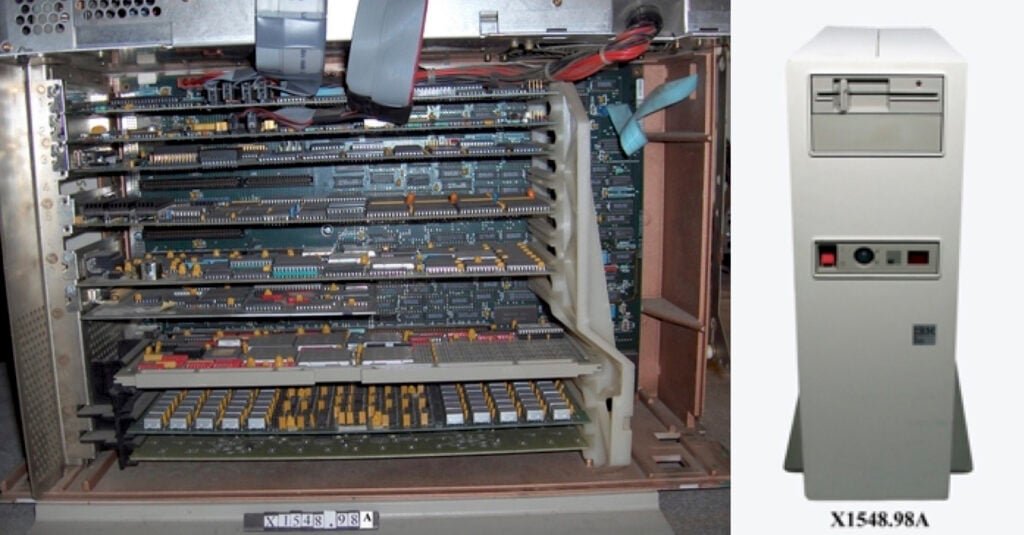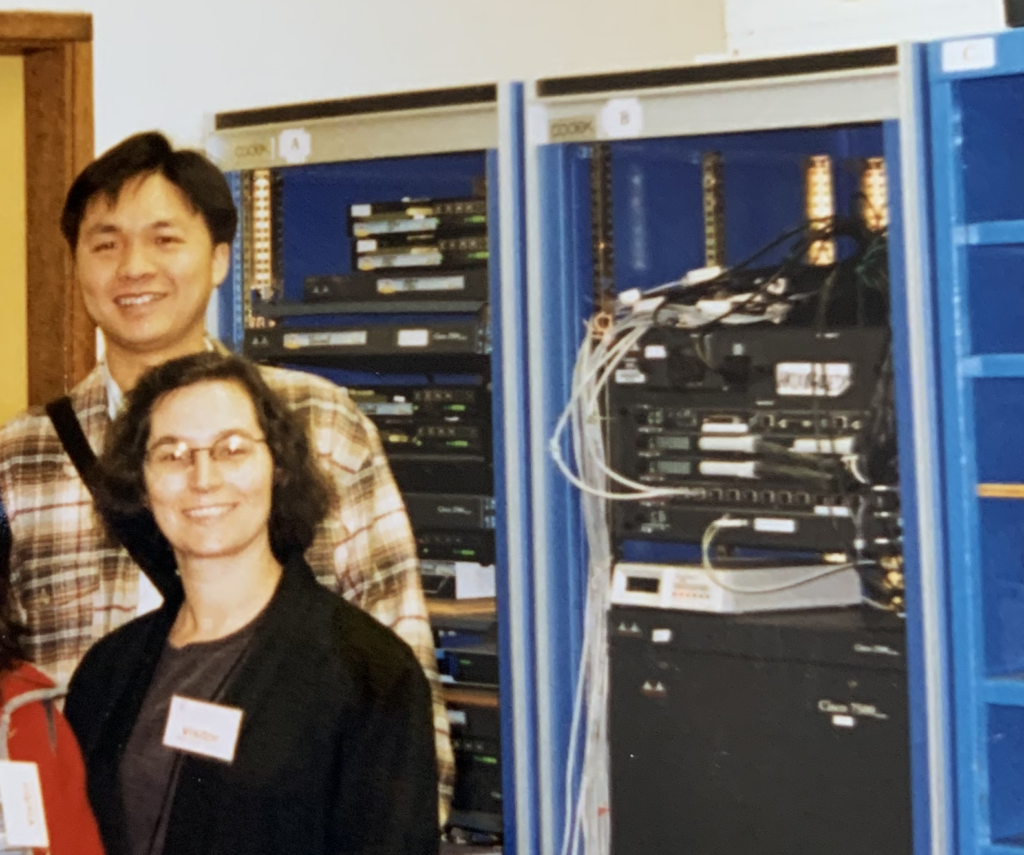
To mark APNIC’s 30-year anniversary, the APNIC Blog is running a series sharing stories, anecdotes, milestones and insights that capture some of the essence of the last three decades.
We’d love to hear your stories and memories of the APNIC community. Post them on social media using the tag #APNIC30th!
Looking at the modern Internet with five billion users (2.6 billion or more in the Asia Pacific region) it can be a little hard to remember that the roots of this part of the modern world lie in a small handful of scientists and academic researchers, meeting face-to-face at computer networking conferences and workshops across the 1980s.
How did we arrive at a community of nearly 24,000 organizations across 56 economies relying on infrastructure we all take for granted, from such small beginnings?
If you’re interested in ‘the world before the Internet’, two good sources are Bob Kahn’s write-up for IEEE at ‘Bob Kahn on the Birth of “Inter-networking” and the film ‘Vive Cyclades’ (in French, with subtitles), which explores the critical role Louis Pouzin played in designing the first packet-switched networks. These both preface the emergence of ARPAnet, and the idea of inter-connection, which naturally led to the inter-net and finally the Internet suite of protocols.
Regarding the birth of APNIC in the Asia Pacific region, the more official histories tell the details, ably researched by Kilnam Chon and others in the Asia Internet History Project and Gerard Ross’s contribution (APNIC’s 20th birthday), in particular.
From small beginnings
Around the early- to mid-1990s, it was clear that the backbone of a worldwide network we call the Internet was demonstrably working as it had already grown bigger than academic and research engineers could manage by themselves.
In the 1980s, the expectation of what a network could do was email and file transfer, and perhaps, some ‘telnet’ functions to log in to remote hosts. The players in this space (at most, about 10,000 people), such as Vint Cerf, Bob Kahn, Bob Braden, Dave Mills, and Peter Kerstein, were predominantly in North America with experimental links over satellite to Europe and parts of Asia.
Although their work was converging rapidly, there was no grand coordinated plan or agreement to go global. The idea of the ‘World Wide Web’ did not exist in the early stages. For much of this time, Internet protocols existed but they ran locally, regionally, or for a lucky few, on the Advanced Research Projects Agency Network (ARPAnet).
At the time, Elise Gerich was representing The National Science Foundation Network (NSFNet), which was the backbone of the US Internet in the 1980s where network usage escalated quickly.
“Prior to the formal establishment of regional registries, it was clear to those of us on the NSFNET team that the backbone was serving a far more global community than just the US Research and Education community. When the T1 NSFNET went live in 1988, there were only two non-US [economies] connected to the NSFNST backbone — Canada and France. Every year after 1988 ten to 12 new [economy] connections were added to the NSFNET routing tables,” Elise recalled.
So, the network engineers of the day responded similarly.
“In 1988, Merit sent an invitation to the 13 Regional Networks that would be connected via the T1 NSFNET backbone. The invitation was to come to Merit and build their own Nodal Switching System (NSS). The NSS was the T1 router, and it was composed of 9 IBM RT systems processors running Berkeley UNIX linked by two token rings with an Ethernet interface to the attached networks. We turned the third floor of the computing centre into an assembly facility, and two regional networks sent representatives to Merit to construct the T1 NSS. The assembly line process worked nicely for quickly building the 13 NSSs and for learning more about the new hardware and software,” Elise said.
For the technically minded, the IBM PC/RT was one of the first ‘RISC’ high-speed computers, using the new reduced-instruction-set model. It was built into the case of a normal IBM PC but was anything but normal and ran the UNIX operating system.

The registry function develops
Around 1990 to 1991, the rapid growth of international research networks across various economies, all seeking to join and interconnect, prompted the need for more organization over basic administrative functions, leading to the authorship of RFC 1366.
“Several folks in the international community and I, especially from the RIPE region, brainstormed about what would be needed to distribute the registry function. We decided it was important to separate the discussions about the two addressing issues of scarcity of addresses and IP address distribution. We would address the need to preserve IP addresses for regions of the world who were just beginning to deploy the Internet,” Elise said.
From 1991 to 1992, public pressure to move beyond academic networking became clear. Nearly every campus connected to the Internet witnessed the emergence of semi-commercial and fully commercial dial-up Internet access models. Internet service provision, as functioning businesses, became viable.
At that time, a loose body of the various national research networks called CCIRN was established, and one was emerging in the Asia Pacific, called APCCIRN.
One of the primary problems facing networks at the time was the maintenance of the unique distribution of Internet number resources, the 32-bit numerical addresses and associated Autonomous System Numbers (ASNs).
“If you were born after 1980, you probably think that we have always had Regional Internet Registries (RIRs). Not true. First, there was Jon Postel who became known as the Internet Assigned Number Authority (IANA), and he recorded the distribution and assignments of IP addresses in a notebook,” Elise said.
The availability of software to run Internet protocols had already been solved by DARPA by funding the development of what became BSD Unix ‘sockets’ for TCP/IP, along with various other implementations for the mainframes of the day (BSD ran on the most popular minicomputers of that time, the Digital Equipment Vax 11/780, and Sun workstations).
“I reached out to Jon Postel and proposed some ideas that had come out of the discussions with the broader Internet community. The leadership of the RIPE NCC was also contacting Postel about the benefits to global communities of having an IP address registry that could address their language needs as well as to locally support their questions about IP addressing,” Elise recalled.

Christian Huitema, a French network researcher working with Internet technologies and deployment since the 1980s, remembers the explosive growth of the time.
“If you remember the 90s, it was a blast. I mean, the network was pretty much doubling in size every year, the traffic was going even faster than that because traffic increased more than proportionally with the number of people on the network,” Christian said.
Missing at the time was a scalable replacement for the single person who implemented and ran the ‘IANA function’ — Jon Postel. IANA was the only unique distribution source of IPv4 addresses (and other assigned numbers) to all participants in the Internet.
As a single-person service, IANA operated at the speed of a single person’s email and fax responses in a single (US) time zone, making for difficulties in the communities of users emerging in Europe and Asia Pacific. There was little or no scope for IANA services, or the Network Information Centre (NIC) function in general, to be run in the local language or reflect local conditions. It was a service that had evolved during the pre-commercial period in a way that the US academic and research community understood.
The need for a scalable replacement for distributing Internet number resources was well understood and frequently discussed at various meetings, including by Tokyo University and the WIDE project’s Jun Murai.
“If approved by the APCCIRN, this pilot project would help determine how to meet the needs in the region over the long term. During the pilot phase, the prime focus would be on the Internet Registry and Routing Registry functions. Limited attention would be given to informational functions until after a decision on a long-term approach for the region. JPNIC has agreed to provide resources for the pilot project,” Jun noted at the time (June 1992).
The cooperating groups forming the APCCIRN came to a consensus that establishing a ‘NIC’ — a trustable source of Internet information coupled with a neutral distribution function — would effectively address this concern. They were ready to allocate funds, connectivity, and voluntary office space to bootstrap a function recognized by all as necessary, to help sustain the developing regional Internet. APNIC’s journey had begun.
APNIC is born
David Conrad was a young researcher working at the University of Hawaii, Manoa, working on a NASA/NSF-funded project that interconnected the networks of universities and research institutions in Japan, Korea, Hong Kong, Australia, New Zealand, and the US. He remembers a fortuitous meeting that happened at the Pacific Communications (PACCOM) Project meeting in 1990.
“I had a wonderful time at my first PACCOM meeting — met Jun, Geoff, Peter Elsford, John Houlker, Kilnam Chon, Taeha Park, Milo Medin, and a whole raft of others. I don’t recall presenting anything at that meeting, but I do remember the traditional ‘economy reports’ where everyone talked about the network developments in their economy and the bandwidth situation (for example, New Zealand at 9600bps). I found it quite fascinating. During that meeting, Geoff received notification that AARNet had received a large chunk of funding, which led to a lot of alcohol and not a lot of additional work getting done,” David recounted.
He shared a memory of how highly informal things were at the time, highlighting the need for an organizational body for increasingly relied-upon networks.
“Perhaps an amusing anecdote, my PACCOM colleague had a rabbit (‘Flopsy’) that she kept uncaged in her office. Flopsy chewed. A lot. There was a 10BASE2 Ethernet cable on the floor (of course) that connected the router to which the international circuits for JP, AU, NZ, HK, and TW were connected and also connected the router where the circuit to the NSFNet connected. One day, we started getting phone calls from researchers both in the US as well as elsewhere complaining about a total connectivity failure traversing PACCOM. Turned out, Flopsy had chewed through the Ethernet cable. This was not a sole occurrence,” David said.
Just as technology’s demand for interconnectedness grew, the same was true for connecting ‘the right’ individuals. So when Jun Murai invited David to move to Japan to help launch the Internet Initiative Japan (IIJ) in 1991, David accepted the invitation and became IIJ’s seventh employee. However, once there, David found that IIJ was facing some delays in getting the licences it needed to provide Internet services.
“I had spare time, and Jun Murai asked if I’d be interested in helping to start up APNIC,” David said.
“APNIC was established in around 1993-1994. It’s a little ambiguous because it wasn’t a formal organization for many years. ICANN was not incorporated until 1998, so it actually predated ICANN,” David continued.
David joined what became APNIC as we know it now in 1992 as the sole, and part-time, employee (albeit working 44-hour weeks!). By 1995, APNIC had three staff: David and Masaya Nakayama part-time and Yoshiko Chong Fong working full-time. Yoshiko visited the RIPE NCC where she learned the practical methods used there to delegate Internet number resources under the emerging RIPE NCC consensus policy process.
“Jon (Postel) was generally pretty laid back and mostly easy to work with. The first time I met him, he took me to a California Pizza Kitchen within walking distance of the ISI office, to talk about the setup of APNIC and delegation of 202/7,” David related.
“Apparently, Jon was nervous about meeting me, which I find mind-boggling to this day. It turned out to be a good 2 1/2-hour lunch where we talked about all sorts of things related to IANA, IETF, the weirdness of the domain name world, and so on. During that lunch, Jon said that he was going to be out the next week, hiking in the Sierra Nevadas. As a few weeks prior there had been a bear attack, I jokingly promised that if he got eaten by a bear, I’d take care of IANA for him (that joking promise played a role in my joining ICANN to become IANA General Manager seven years later),” David joked.
By this stage at the end of 1995, just three years into the APNIC ‘experiment’, a total of 747 allocations equivalent to 45,473 /24 networks had been delegated to 125 direct delegates, and indirectly to more through eight affiliated national entities (some of which became the NIRs). Some had already justified larger holdings than others, reflecting one of the primary goals of address policy — adjusting assignment sizes to reflect justified need, rather than the fixed-size classful model of network distribution that had already proven ineffectual.
APNIC’s Chief Scientist, Geoff Huston, who led the initial construction of the Internet in Australia in the late 1980s for AARNet and the development of Australia’s first commercial ISP network, perhaps summarizes this era best:
“It took a long time to realize ‘we’d won’ and nobody felt we had ‘adult supervision’. If you look at all the ‘80s conversations, we kept wondering when ‘the adults are coming’. But even up into the ‘90s, it still felt like an experiment. There were really no ‘old’ people… We were mostly all under 40, running on a shoestring, university-oriented budget,” Geoff said.
APNIC in 2023
Rolling forward to 2023, APNIC has around 9,000 direct Members and 14,000 in the National Internet Registry (NIR) model — a total of around 24,000 different resource holders with 3.5 million /24 network equivalents. That’s 40x growth in the participating membership and over 75x growth in the address holdings — almost twice as many holdings per Member than at the start! Considering that one of the primary concerns in the 1990s was fear of ‘running out too soon’, to have gone on another 28 years and still be able to perform the NIC function is quite remarkable.
The quotes in this article were sourced from private communications or public postings. Some have had minor edits for clarity.
The views expressed by the authors of this blog are their own and do not necessarily reflect the views of APNIC. Please note a Code of Conduct applies to this blog.
